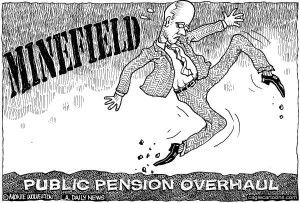Brown, Legislature advance phony pension ‘reform’
By Wayne Lusvardi
There are many books that have sprung up with titles such as “The 2 Percent Solution,” “The Four Percent Solution,” “The Five Percent” solution, “The One Percent Solution,” the 999 Plan, all offering simplistic solutions to stubborn problems.
California Gov. Jerry Brown and the Democrat-run California Legislature could have added their own jingoistic book title on Tuesday Aug. 18, titled, “California’s Four Percent Solution to its Pension Crisis (or: Everything the State Legislature and Unions Selectively Want You to Know About the California Pension Crisis”).
What Brown and the Legislature didn’t say is that their compromise plan would provide about $20 billion in cost savings out of $500 billion in unfunded pension liabilities, according to Scott Shackford of the Reason Public Policy Institute. That is a cost savings of about 4 percent of unfunded pension fund liabilities starting maybe in 2030 to 2050. Daniel Borenstein calls it “pension reform lite.” Although specifics have been intentionally left murky by the Legislature, this does not appear to include retiree medical benefits.
In other words, the joint plan plan does nothing to address the pension cost shock that is already forcing many California cities into bankruptcy courts or compelling them to seek other desperate solutions.
Risky solutions
One other solution has been for communities to mortgage their future with deferred interest “capital appreciation bonds.” Another has been to explore the risky use of eminent domain to spread the overmortgaged portion of home loans to all property owners in San Bernardino County. Another potential solution is municipal disincorporation.
Most of the specifics of Brown’s and the Legislature’s pension reform plan have not been revealed to the public. But one component of the plan is to limit pensions to $110,000 per year for those public retirees who are not police or firefighters. Coincidentally, that is the same estimated pension benefit level that Brown would be eligible for when he retires.
Gov. Brown is desperate. He needs to show some symbolic pension reform for his tax proposal, Proposition 30 on the November ballot, to gain acceptance with the voters. It should be made clear, however, that the current pension reform being negotiated by Brown with the Legislature is not the same Twelve Point Plan he proposed in 2011. He has apparently abandoned that plan due to push back by the Legislature and unions.
One of the more aggressive parts of Brown’s earlier pension reform plan was to ask public employees to pay for half of the cost of their pensions. But as Joshua Rauh of the Hoover Institution at Stanford University points out, this “would only be asking public employees to pay one-quarter of the cost of their pensions.” This is because the estimated cost of pensions is about half of the true cost due to using overly optimistic investment interest rate assumptions. One half of 50 percent is 25 percent.
Without proper use of conservative interest rate returns on pension fund investments, that will result in only cosmetic reforms. Newspaper headlines based on union press releases are declaring: “Brown Gets Partial Win in Pension Reform.” The part they left out is that the proposed reforms don’t kick in until maybe 2030 and are only half of what they are stated to be.
As Rauh sums it up: “While politicians in Sacramento will doubtless use this as an opportunity to declare victory, in truth they will only slightly reduce the breakneck speed at which the state of California is hurtling towards an all-out fiscal crisis.”
Related Articles
Nestande's Hilarious Hypocrisy
Steven Greenhut: Assemblyman Brian Nestande, R-Palm Desert, released a statement following the governor’s State of the State speech that left
Taxes Up – No Need for Increases
John Seiler: A month ago, I was the first to point out that ongoing tax cuts in California were producing
Trash train fiasco illustrates private vs. public double standard
This story in the Orange County Register illustrates a common CalWatchdog theme: In the private sector, incompetence leads to companies




